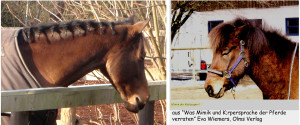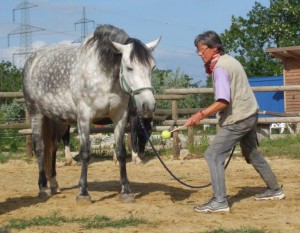Understand your Horse – Part 08
Ears instalment 2
|
|
Ihr Pferd verstehen – Teil 08
Fortsetzung Ohren 2
|
- In the last part we started looking at the ears of the horse by themselves, trying to find out what they can tell us about his emotional state. We saw attentive ears, which could be more or less relaxed. We analysed neutral ears as well – and again realised that any expression of the mood will be overridden by the function – the ears will swivel to the newest interesting sound regardless of the horse’s mood.
4. Sleepy Ears:
- Sleepy ears are flopped sideways and of course very relaxed. They go along with half closed eyes and a hanging lower lip. When the horse is sleepy, he will usually hang his head as well – the height depends on the depth of the sleep. With some horses the head sinks lower and lower… until you think they will fall over any minute! Some horses even snore quite audibly!
|
|
- Im letzten Teil haben wir angefangen die Ohren des Pferdes isoliert zu betrachten, um herauszufinden, was sie uns über seinen Gefühlszustand sagen können. Wir haben „aufmerksame Ohren“ betrachtet, die mehr oder weniger entspannt sein können. Auch neutrale Ohren haben wir erkennen gelernt – und dabei wieder erfahren, daß die Funktion jederzeit vor dem Gefühlsausdruck Vorrang hat, egal wie das Pferd sich fühlt.
4. Schlafohren:
- Schlafohren sind seitlich abgesenkt und natürlich sehr entspannt. Das ist begleitet von halb geschlossenen Augen und einer hängenden Unterlippe. Wenn ein Pferd schläft senkt sich oft auch der Kopf – die Höhe hängt von der Tiefe des Schlafs ab. Bei manchen Pferden sinkt der Kopf tiefer und tiefer… bis man das Gefühl hat, das Pferd fällt gleich um! Manche schnarchen dabei auch hörbar!
|
 Relaxed airplane ears – hanging head – hanging lower lip – kinked hind leg – all signs of sleep.
Entspannte Flügelohren – hängender Kopf – hängende Unterlippen – angewinkelter Hinterfuß – alles Anzeichen von Schlaf.
|
- On the left you see a sleepy horse with ears held almost horizontally. His right hind leg is resting, but the eyes are not really shut – he is dozing, but not entirely trusting – still paying attention to the surroundings! Second from left you see a sleeping horse with totally closed eyes and hanging head – but the ears are still pointed! He must have heard me sneaking up on him… Similar to the two in the next picture, where you can nicely recognize the relaxed lower lip. Deena on the right is the horse who falls into such deep sleeps that she nearly topples over… you see ALL the signs: resting hind leg, sideways flopped ears, hanging lip and fully closed eyes. Sweet dreams!
- For the communication with us sleepy ears are not so significant, except for the fact that it is perhaps not the best and most motivated time to take your horse out for a good work session, when you find him like this. However, we have to learn to discern between sleepy and “questioning” or depressed ears! Not all ears, which are dropped sideways are relaxed, sleepy – or content!
5. Helpless ears, at a loss:
- When a horse is at a loss and feels helpless, his ears will also be drooped sideways. The pony in the right picture is not sleeping!
|
|
- Links sieht man dösendes ein Pferd mit fast horizontalen Ohren. Sein rechtes Hinterbein ist angewinkelt, aber die Augen sind nicht ganz geschlossen – es döst zwar, aber ist nicht ganz vertrauensvoll – ein bißchen paßt es auf die Umwelt noch auf! Auf dem zweiten Foto von links sieht man ein schlafendes Pferd mit ganz geschlossenen Augen und hängendem Kopf – aber die Ohren sind noch gespitzt! Vielleicht hat er mich beim Anschleichen gehört… Ähnlich wie die zwei im nächsten Bild, wo man schön die entspannten Unterlippen erkennen kann. Deena ganz rechts ist ein Pferd, die in solchen Tiefschlaf fällt, daß sie fast umkippt… hier sieht man ALLE Anzeichen: das angewinkelte Ruhebein, die seitlich abgeklappten Ohren, die hängende Lippe und ganz geschlossene Augen. Träum süß!
- Für die Kommunikation mit uns sind Schlafohren nicht so wichtig, außer für die Tatsache, daß es, wenn Sie Ihr Pferd so vorfinden, vielleicht nicht die beste Zeit ist, es für eine gute Arbeitsstunde zu holen. Wir müssen jedoch lernen zwischen Schlafohren und „fragenden“ oder deprimierten Ohren zu unterscheiden! Nicht alle Ohren, die seitlich abgesenkt sind, sind entspannt, dösend – oder zufrieden!
5. Ratlose Ohren:
- Wenn ein Pferd ratlos ist und sich hilflos fühlt, senkt es seine Ohren ebenfalls seitlich ab. Das Pony in diesem Bild rechts schläft nicht!
|
 Left: this horse is sleeping – see the hanging lip! Right: this pony is sadly at a loss – tight mouth! He needs help!
Links: dieses Pferd schläft – siehe Hängelippe! Rechts: das arme Pony ist ratlos – angespanntes Maul! Es braucht Hilfe! |
- The horse on the left is sleeping… you recognize the totally relaxed lower lip. The pony on the right is at a loss – the mouth is tight-lipped.
- It stands to reason that it is very important to recognize this state of emotion! Imagine a poor horse being reprimanded for being inattentive and sleepy, when in fact he is telling you that he is at a total loss about what you want – and therefore not happy either!
- When feeling helpless the ears are dropped to the side with the openings down and directed toward the body – as if the horse were listening into its own body. The eyes are half closed, trying to shut out the troubles and difficulties of this world. But the lower lip is not hanging – the mouth is not relaxed!
- Of course the situation will also give you clues: a horse usually does not drop off to sleep suddenly in the middle of a work session – when you see a face like this while you are engaged in any activity with your horse, you have good reason to check whether he is not feeling at a loss!
|
|
- Das Pferd links schläft… man kann gut die entspannte Unterlippe erkennen. Das Pony rechts ist ratlos – das Maul ist verspannt.
- Es ist klar, daß es sehr wichtig ist, diesen Gefühlszustand zu erkennen! Stellen Sie sich vor, daß ein armes Pferd dafür beschimpft wird, daß es dösig oder unaufmerksam ist, wenn es Ihnen doch wirklich mitteilt, daß es keine Ahnung hat, was Sie wollen – und daher auch nicht glücklich ist!
- Ratlose Ohren werden seitlich mit den Ohrmuscheln nach unten und in Richtung auf den eigenen Körper gesenkt, als ob das Pferd in seinen eigenen Körper hinein lauscht. Die Augen sind halb geschlossen, als ob es versucht, die Probleme des Lebens auszublenden. Aber die Unterlippe hängt nicht – das Maul ist nicht entspannt!
- Natürlich bekommen wir auch Anhaltspunkte aus der Situation: ein Pferd kippt ja nicht mitten in einer Arbeitsperiode auf einmal in den Tiefschlaf – wenn man also während einer Aktivität plötzlich so ein Gesicht sieht, muß man immer nachprüfen, ob das Pferd sich nicht ratlos fühlt!
|
|
|
- In this picture you see a horse being target trained, when all of a sudden it all becomes too much for her and she says: “Sorry, I can’t concentrate any more – please leave me in peace!” Can you recognize the slightly pinched mouth and nostrils?
- Ears can be drooped sideways in various degrees: the scale of emotions can range from questioning ears (see next point) to helpless ears and all the way to depressed ears.
6. Questioning Ears:
- Questioning ears you will encounter all the time! Questioning ears are not lifeless – you will often see quick successions between sideways dropped and pointed attentively. Again you see the sideways dropped ears – this indicates the horse’s feeling of uncertainty. He is waiting for your feedback and needs your guidance!
|
|
- In diesem Bild sieht man ein Pferd, welches Target Training lernt, als auf einmal alles zu viel wird. Sie sagt ganz klar: „Ich kann mich jetzt nicht mehr konzentrieren – bitte laß mich in Ruh!“ Können Sie das angespannte Maul und Nüstern erkennen?
- Die Ohren können seitlich auf verschiedene Tiefe abgesenkt werden: die Skala der Gefühle geht von „fragenden Ohren“ (siehe nächster Punkt) über „hilflose“ bis zu „deprimierten“ Ohren.
6. Fragende Ohren:
- Fragende Ohren werden Sie dauernd zu sehen bekommen! Diese sind nicht leblos – oft sieht man auch einen schnellen Wechsel zwischen der seitlichen Haltung und aufmerksam gespitzten Ohren. In diesen Fotos sieht man wieder die seitliche Position – die drückt ein Gefühl der Unsicherheit aus. Das Pferd erwartet ein Feedback von Ihnen und braucht Ihre Anleitung!
|
 Questioning ears – Fragende Ohren |
- You see a variety of expressions here, though all these ears are questioning. The pony on the left holds his ears quite horizontally (he is clearly questioning!) but his eyes show that he is not unhappy, though his mouth is tense. In the off-line game with Peter you see that the ears are higher – still questioning, but rather an interested way and not at a loss. He knows in general what I want from him – he is just asking for details! In the running game with Chelsea Beau is very self-assured – not at a loss at all! His questioning ear, which is directed toward her, merely wants to know the tightness of the upcoming turn – he is waiting for a detailed direction and is happy and attentive at the same time.
|
|
- Man sieht hier eine Vielseitigkeit des Ausdrucks, obwohl alle diese Ohren „fragend“ sind. Das Pony links hält seine Ohren fast ganz horizontal (es fragt eindeutig nach etwas!), aber seine Augen zeigen, daß es nicht unglücklich ist, obwohl sein Maul angespannt ist. In dem Freiheitsdressur-Foto mit Peter sieht man höhere Ohren – auch fragend, aber eher in einer interessierten Art und nicht total hilflos. Er weiß ja im Großen schon, was ich von ihm will – er hinterfragt nur die Details! In dem Laufspiel mit Chelsea ist Beau sich seiner sehr sicher – er ist nicht ratlos! Sein eines „fragendes“ Ohr ist auf sie gerichtet, weil er die Enge der kommenden Kurve wissen will – er erwartet eine detaillierte Anleitung und ist glücklich und aufmerksam bei der Sache.
|
|
In the next Blog we will continue with more interesting ears expressions!!
Read on !!
|
|
Im nächsten Blog kommen noch mehr interessante Ohren!
Lesen Sie weiter !!
|





